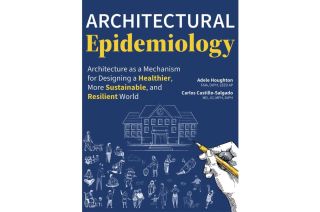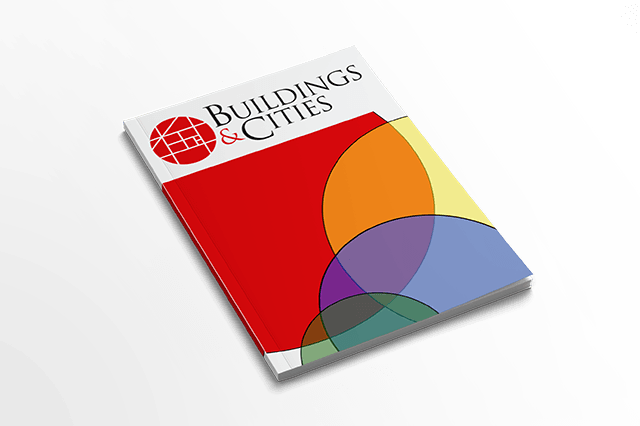
www.buildingsandcities.org/insights/reviews/carbon_neutral_design.html
Carbon Neutral Architectural Design
By Pablo M. La Roche. CRC Press, 2024, ISBN: 9781003014829
Ian Taylor reviews this book, which he praises as a must-read for anyone interested in carbon neutral design and sustainable architecture. The far-reaching implications of this book are expected to provide a valuable reference for researchers, policymakers, practitioners, and the general public alike.
La Roche explains the importance of carbon neutral design in the context of climate change, highlighting how building form, material choice, energy use, water and waste impact on emissions. He draws on his experience as professor of architecture at California State Polytechnic University, and interim director of the Lyle Centre for Regenerative Studies in the College of Environmental Design, as well as a principal and sustainable design services lead at Arcadis, to present examples of his arguments towards the development of more passive and nature-based solutions through the design of climate-responsive building envelopes that harvest energy, and reduce or eliminate the need for heating, mechanical ventilation, and cooling systems.
One of the key strengths of the book is its ability to balance theoretical explanations with practical applications. La Roche explains the physics behind various design solutions from first principles, demonstrating the relevance of particular approaches to improving comfort and reducing energy demands and carbon impacts. The use of clear graphic diagrams helps illustrate the inter-relationships between energy transfers and human comfort, providing strong design leads that should help develop fruitful design initiatives.
The book's focus on thermal comfort and climate is particularly noteworthy. La Roche argues that an understanding of the climate and interpretation of climatic data should underpin all design work, explaining climate classification systems and demonstrating how these can provide data for design to respond to. The discussion of bioclimatic design, including the use of bioclimatic charts and digital climate analysis tools, is also a highlight, providing a clear and compelling case for the benefits of designing buildings that work with, rather than against, their environmental context.
The book provides a wealth of information on current research and best practice in carbon neutral design. For example, La Roche explains the physiological explanation of our perception of comfort, including the importance of heat balance and the relative impacts of air temperature, radiation, air motion, and relative humidity on human comfort. He also discusses the consideration that should be given to personal and environmental factors such as weight and age, which impact on an individual's acceptable upper and lower limits of comfort.
The explanation of adaptive comfort and the research examples given provide a compelling case for the benefits of the free-running building over one that is mechanically ventilated and cooled. La Roche describes how our expectations, degree of personal control, and the relationship to external conditions influence our acceptance of what is considered to be comfortable. Psychological, social and cultural factors are now seen to have more impact than considered in the original adaptive comfort criteria, and adjustments for differences in clothing influence the experience of spaces.
The book also discusses the importance of designing for outdoor thermal comfort, demonstrating how the consideration of these same principles can improve external conditions – especially important in more extreme climates where external air temperatures, surface radiation, air movement, and high relative humidity can make conditions intolerable for large periods of time. Design tools that can help understand the empirical impacts of providing shade, developing cooler surfaces, and changing air movement are described with clear diagrams and references.
La Roche's experience as a teacher and researcher is evident throughout the book, which will serve very well as a design primer for students. Each chapter offers nuggets of useful information, links to resources, and wisdom that will fill gaps in knowledge and encourage further enquiry. The book is a specialist book, for those who recognise the importance of the topic and the general principles but are looking for a more detailed assessment, and a sense check to give guidance beyond the greenwash of current sustainable design credentials.
The implications of this book are far-reaching, with potential applications for researchers, policymakers, practitioners, and the general public. For researchers, the book provides a wealth of information on current research and best practice in carbon neutral design, as well as a comprehensive bibliography and clear index. For policymakers, the book highlights the importance of incorporating carbon neutral design principles into building codes and regulations. For practitioners, the book provides practical insights and design leads that can be applied to real-world projects. And for the general public, the book raises awareness of the critical role that buildings play in contributing to greenhouse gas emissions and the need for urgent action to reduce these impacts.
Overall, this book is a must-read for anyone interested in carbon neutral design and sustainable architecture. Its comprehensive coverage, clear explanations, and practical insights make it an essential resource for practitioners, researchers, and students alike. As La Roche notes, reducing anthropogenic emissions is more critical than ever, and this book provides a timely and important contribution to the ongoing debate about how to achieve carbon neutral buildings.
The book's conclusions on the importance of architecture that relates to the particular microclimate of the location, and allows for an active role for the occupants of the building to adjust its operation to influence their comfort, is a clear rallying cry. The comprehensive bibliography, which includes extensive published research papers that form the backdrop to much of the content in the book, together with the clear index, make this book a really useful primer on the topic of low carbon design, whether you are a design architect or engineer, a researcher, a student or teacher.
In terms of its contribution to current knowledge and research, the book makes a significant impact by providing a detailed assessment of the importance of carbon neutral design and the role that architects and designers can play in reducing building emissions. La Roche's intent is clear: to provide a comprehensive primer for carbon neutral design that will help achieve the urgent goal of reducing greenhouse gas emissions from buildings.
The book provides a wealth of information on current research and best practice in carbon neutral design, including the use of digital climate analysis tools such as Ladybug, CLIMATESCOUT, and IESve. The discussion of bioclimatic design, including the use of bioclimatic charts, is also a highlight, providing a clear and compelling case for the benefits of designing buildings that work with, rather than against, their environmental context.
Throughout the book, La Roche draws on his research experience at UCLA and Cal Poly Pomona to present examples of passive cooling and heating strategies, including evaporative cool towers and indirect evaporative cooling using ponds on roofs. These innovative approaches offer significant opportunities for reducing energy demands and carbon impacts, and demonstrate the potential for nature-based solutions to play a major role in achieving carbon neutral buildings.
In conclusion, this book is an essential read for anyone committed to developing architecture using fewer resources and operating with lower energy demands. Its comprehensive coverage, clear explanations, and practical insights make it a valuable resource for practitioners, researchers, and students alike. The book's focus on thermal comfort, climate, and bioclimatic design provides a wealth of information on current research and best practice in carbon neutral design, and its implications are far-reaching, with potential applications for researchers, policymakers, practitioners, and the general public.
Latest Peer-Reviewed Journal Content
Designing for pro-environmental behaviour change: the aspiration–reality gap
J Simpson & J Uttley
Lifetimes of demolished buildings in US and European cities
J Berglund-Brown, I Dobie, J Hewitt, C De Wolf & J Ochsendorf
Expanding the framework of urban living labs using grassroots methods
T Ahmed, I Delsante & L Migliavacca
Youth engagement in urban living labs: tools, methods and pedagogies
N Charalambous, C Panayi, C Mady, T Augustinčić & D Berc
Co-creating urban transformation: a stakeholder analysis for Germany’s heat transition
P Heger, C Bieber, M Hendawy & A Shooshtari
Placemaking living lab: creating resilient social and spatial infrastructures
M Dodd, N Madabhushi & R Lees
Church pipe organs: historical tuning records as indoor environmental evidence
B Bingley, A Knight & Y Xing
A framework for 1.5°C-aligned GHG budgets in architecture
G Betti, I Spaar, D Bachmann, A Jerosch-Herold, E Kühner, R Yang, K Avhad & S Sinning
Net zero retrofit of the building stock [editorial]
D Godoy-Shimizu & P Steadman
Co-learning in living labs: nurturing civic agency and resilience
A Belfield
The importance of multi-roles and code-switching in living labs
H Noller & A Tarik
Researchers’ shifting roles in living labs for knowledge co-production
C-C Dobre & G Faldi
Increasing civic resilience in urban living labs: city authorities’ roles
E Alatalo, M Laine & M Kyrönviita
Co-curation as civic practice in community engagement
Z Li, M Sunikka-Blank, R Purohit & F Samuel
Preserving buildings: emission reductions from circular economy strategies in Austria
N Alaux, V Kulmer, J Vogel & A Passer
Urban living labs: relationality between institutions and local circularity
P Palo, M Adelfio, J Lundin & E Brandão
Living labs: epistemic modelling, temporariness and land value
J Clossick, T Khonsari & U Steven
Co-creating interventions to prevent mosquito-borne disease transmission in hospitals
O Sloan Wood, E Lupenza, D M Agnello, J B Knudsen, M Msellem, K L Schiøler & F Saleh
Circularity at the neighbourhood scale: co-creative living lab lessons
J Honsa, A Versele, T Van de Kerckhove & C Piccardo
Positive energy districts and energy communities: how living labs create value
E Malakhatka, O Shafqat, A Sandoff & L Thuvander
Built environment governance and professionalism: the end of laissez-faire (again)
S Foxell
Co-creating justice in housing energy transitions through energy living labs
D Ricci, C Leiwakabessy, S van Wieringen, P de Koning & T Konstantinou
HVAC characterisation of existing Canadian buildings for decarbonisation retrofit identification
J Adebisi & J J McArthur
Simulation and the building performance gap [editorial]
M Donn
Developing criteria for effective building-sector commitments in nationally determined contributions
P Graham, K McFarlane & M Taheri
Join Our Community

The most important part of any journal is our people – readers, authors, reviewers, editorial board members and editors. You are cordially invited to join our community by joining our mailing list. We send out occasional emails about the journal – calls for papers, special issues, events and more.
We will not share your email with third parties. Read more



Latest Commentaries
COP30 Report
Matti Kuittinen (Aalto University) reflects on his experience of attending the 2025 UN Conference of the Parties in Belém, Brazil. The roadmaps and commitments failed to deliver the objectives of the 2025 Paris Agreement. However, 2 countries - Japan and Senegal - announced they are creating roadmaps to decarbonise their buildings. An international group of government ministers put housing on the agenda - specifying the need for reduced carbon and energy use along with affordability, quality and climate resilience.
Building-Related Research: New Context, New Challenges
Raymond J. Cole (University of British Columbia) reflects on the key challenges raised in the 34 commissioned essays for Buildings & Cities 5th anniversary. Not only are key research issues identified, but the consequences of changing contexts for conducting research and tailoring its influence on society are highlighted as key areas of action.